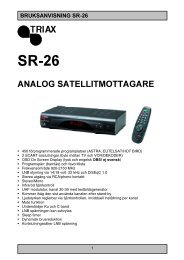TRIAX Multimedia Main Catalogue
TRIAX Multimedia Main Catalogue
TRIAX Multimedia Main Catalogue
You also want an ePaper? Increase the reach of your titles
YUMPU automatically turns print PDFs into web optimized ePapers that Google loves.
Terrestrial antennas<br />
Introduction<br />
Radio antennas<br />
Stereo signals can be received using any FM antenna.<br />
Because, however, a higher signal level and greater freedom<br />
from reflection are needed for clear stereo reception than for<br />
mono reception, it is usually necessary to use a directional<br />
antenna.<br />
Television antennas for DVB-T<br />
DVB-T reception is possible with any antenna that is<br />
suitable for the related frequency band and polari zation.<br />
In the catalogue all antennas suitable for the reception of<br />
DVB-T signals in VHF III and UHF IV/V bands are<br />
marked with the DVB logo .<br />
2 1 Side lobe<br />
U r<br />
Average of 1 and 2<br />
U v<br />
<strong>Main</strong> lobe<br />
-3 dB<br />
Angle of acceptance<br />
Omnidirectional reception<br />
The omnidirectional radio antenna has approximately<br />
the same sensitivity for all directions and can only be<br />
recommended for well supplied reception areas.<br />
Radiation pattern –<br />
The most important terms<br />
Gain<br />
Ratio of an antenna’s reception power in its main receiving<br />
direction to receive power of a l/2 dipole at the same<br />
installation site (logarithmic measure expressed in dB)<br />
Angle of acceptance<br />
Angular aperture of the major lobe between the points<br />
where the gain is lower by 3 dB than its maximum value<br />
Major lobe<br />
Section of the radiation pattern in the direction of the<br />
maximum gain<br />
Directional reception<br />
The directional antenna receives signals from one main direction<br />
better than omnidirectional antennas, but has<br />
poorer reception of signals from other directions.<br />
A directional antenna is absolutely necessary for areas<br />
where signals are weak, or in areas where a particular weak<br />
transmitter is to be received.<br />
Side lobe<br />
Lateral and rearward lobe-shaped sections of the radiation pattern<br />
that have a lower gain than in the main receiving direction<br />
Front to back ratio*<br />
Ratio of the voltage Uv in the main receiving direction to<br />
an average Ur generated on the basis of the voltages of<br />
the side lobe 2 in the back direction (180°) and of the<br />
larger side lobe 1 in the rear sector (90°-270°)<br />
(logarithmic measure expressed in dB)<br />
* Corresponding to a definition by the Technical Commission<br />
of the “Receiving Antennas” association in ZVEI<br />
Antennas are suitable for<br />
the reception of digital<br />
TERestrial signals (DVB-T)<br />
246








![Triax product info - DVB-C modul TDH [DK - GB].indd](https://img.yumpu.com/48426483/1/184x260/triax-product-info-dvb-c-modul-tdh-dk-gbindd.jpg?quality=85)








